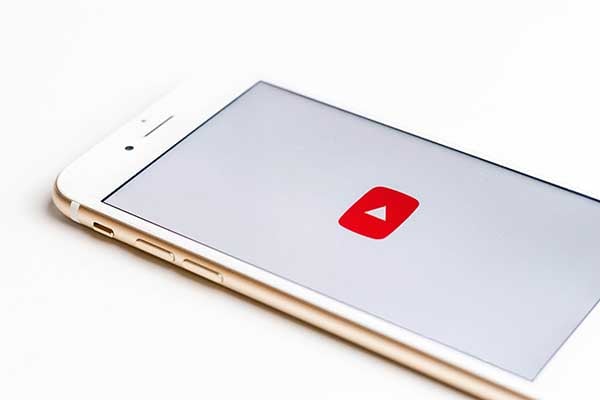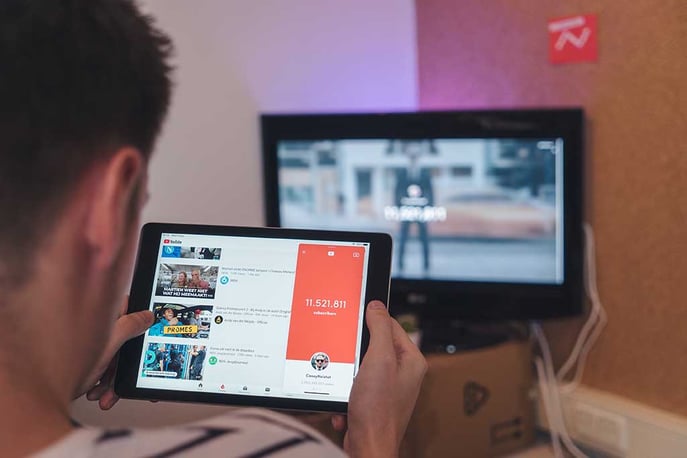YouTube Video Marketing: The Guide
- Home
- YouTube Video Marketing: The Guide
Curiously, the second most popular website in the world doesn't get more attention in the marketing world.
This is part of our collection of guides to video marketing. Video marketing is a key component of the inbound methodology and a great way to attract new visitors to your website.
Video marketing stats show that almost two billion users log into YouTube every month, and that doesn't even include the countless visitors who don't have an account or haven't logged in. And yet, it doesn't even tend to show up in the typical lists of most popular digital marketing channels.

One reason might be the complexity of this marketing opportunity. Simply put, you cannot treat YouTube as just another social media network. It's a fully-fledged video platform, search engine, and social network. It has the potential to drive significant business and brand loyalty, but only if you approach it the right way and turn YouTube into a powerful marketing tool.
This article will explore what the right way looks like. Despite its complexity, YouTube is worth exploring thanks to both its popularity and the fact that we're becoming an increasingly visual society Consider this your comprehensive guide to YouTube as the core of your video marketing efforts. More specifically, we'll explore the process of building a channel and content strategy, optimising your videos, and growing subscribers to make an increasing impact over time.
Stage 1: Build Your YouTube Channel
Successful YouTube marketing begins long before you optimise your videos. Your channel is the foundation of everything you do, so it only makes sense that you focus on it first before diving into any video specifics.
You'll recognise many familiar marketing concepts below. YouTube is a video-focused platform, but it's still an online presence that requires much of the same optimisation techniques as your website or other social media channels would. It's common-sense digital marketing, with a twist.
How to Position Your YouTube Strategy
Naturally, you need a strategy. YouTube has more than 23 million channels posting videos daily. You need to make sure that yours stands out and attracts visitors and viewers.

Image by Pickwriters
That starts with competitive research. Look at what other channels are doing, and how they are positioning themselves. Ask yourself:
-
What am I trying to accomplish in creating a YouTube channel?
-
Who is my target audience? Who am I trying to reach?
-
What types of videos do those users like to watch?
-
How are my competitors (direct and indirect) trying to satisfy those needs?
-
How can my channel become unique and stand out from the crowd?
Answers to these questions help you understand exactly how your YouTube strategy needs to be built. Ideally, you should create a written document that outlines your goals, target audience, competitors, and the steps you need to get there.
That final step requires a posting schedule of videos, which can be time-intensive to create but is significant in building a consistent YouTube presence. You might not have the bandwidth to create enough videos for daily posting, but a regular cadence that sticks to your unique positioning goes a long way towards a successful implementation of your strategy.
Building the Actual Channel
With the strategy in place, it's time to jump into the platform. Various aspects of your channel will become relevant here; some, like your profile image, are relevant for every potential viewer. Others are more relevant to subscribers who visit your channel homepage.
Building your YouTube channel requires you to become familiar with all of these aspects:
-
Your channel name appears anywhere from YouTube search results to the footer of each video you post. Most businesses choose their brand names; if you plan to build a personal presence, your full name makes more sense. Make sure your name is unique before you set it to avoid any confusion for potential subscribers.
-
Your channel icon, which appears anywhere from the videos themselves to comments you leave and your subscriber's subscription pages. A headshot makes sense for individuals, and a company logo for brands. Just make sure it looks good and stays readable even as a small thumbnail image.
-
Your YouTube banner is the header image that appears at the top of your channel anytime a user visits it. This is your opportunity to get graphically creative, but make sure that it accurately represents your brand and the purpose of your channel.
-
Your channel description is a summary of what the channel is about. It shows up both on the channel page and on search results where your channel pops up. But in these search results, only the first 100 characters display, so make sure you fit the most important, user-facing copy there. Include keywords relevant to your audience.
-
Video playlists, which group videos together based on topic or audience interest. These only make sense once you've built a library of content, at which point they become a major piece in keeping your channel organised and clean.
Build it like your website. More consistency is better, to ensure that anyone already familiar with your brand can easily understand who (and what) they're dealing with. And of course, you can refresh, update, and optimise each of these elements over time to keep your channel relevant.
Choosing a Channel Trailer that Represents Your Brand
The final piece of your channel is your channel trailer, the feature video that highlights what the entire YouTube presence is about. Choose a video that best represents your brand; it might be a short trailer TV commercial or an introduction to your products and services.

Make sure you keep the trailer short (30-90 seconds works best), relevant, and to the point. Pay special attention to its headline and description, which will show up alongside it on your homepage.
Stage 2: Optimise Your Videos for Traffic and Viewers
Your channel is built. Now, it's time to think about exactly what you want out of your videos. That includes both creating the videos themselves and optimising them for the unique SEO opportunities YouTube holds. Let's discuss each of these components in more depth.
Best Practices in YouTube Video Creation
Creating a video is easy. You just point your camera, hit record, and upload. Millions of those videos exist on YouTube. Unfortunately, none of them generates any views or engagement. That's because creating a video designed to get your audience's attention is much more complex.
It starts with a plan. Based on your channel strategy, think about exactly what you want the video to accomplish. Then, think through the details of the video itself. You might even create a rough script that guides the content, both visually and textually.
Outline the key points you want to make, then make sure they flow naturally from one to the next. Make sure you don't plan for too much--a few minutes can go quickly in the video, and you have to make sure every second of your content stays relevant to your audience.
Next, shoot the video itself. Try to find something that makes the video unique (a unique angle, maybe), but the key here is high production quality. No background noise, no light behind the camera, and no distractions in the background. Make sure you frame the shot right and vary between wide (far-away) shots and close-ups to keep it interesting.

Never assume that simply shooting your video is enough. You also have to edit it, which includes becoming familiar with software like iMovie. Familiarise yourself with simple adjustments like colour correction, and add b-rolls or graphics as your skill allows you to make the video more visually interesting.
The typical marketing video is done at this point. YouTube marketers should familiarise themselves with a few extra points:
-
Cards, which are overlays that allow you to promote and highlight a call to action or other, related videos while your audience is watching the content. Add them later in your videos to keep your audience hooked and avoid redirecting them away from the current video too soon.
-
The endscreen is essentially a card at the end of the video. Here, you can use most of the screen to promote other videos or your brand/products, while the content plays out. It's a great opportunity to include a subscribe button and grow your subscribers.
-
The video thumbnail is a clickable icon that represents the content before anyone starts watching. You can leave it as-is, but YouTube claims that 90% of top-performing videos have custom thumbnails. Take a screen from the video itself, but make it more visually attractive through higher contrast and potential extra graphics. Those extra clicks and views will be worth your effort.
-
Video captions. These are essential for accessibility. YouTube automatically creates them, but you might want to take a look and check for grammar, custom names, etc. A sizable minority of YouTube users watch videos without sound, only adding to the importance of this component.
How to Optimise Your Marketing Videos for SEO
With the videos created, it's time to start thinking about the viewers they could potentially attract. We often talk about search engine optimisation in terms of Google and other text-based systems, but YouTube is a major player in its realm. Between its internal search and the videos appearing in Google results, optimising your videos for searches is a central part of any successful YouTube marketing strategy.

YouTube SEO deserves its guide, but a few simple steps can help you get started in the process:
1) Perform Keyword Research
Finding the right keywords on YouTube is not necessarily complex. Just go into the search box, and start typing a keyword relevant to your industry or audience. As is the case with Google, YouTube Suggest will begin to autofill the keyword with some of the most popular phrases from other searches.
Another option is to utilise Google Trends, which has a YouTube search option with exact volume data. Use these tools to find the topics your audience is interested in, then build your videos accordingly.
2) Optimise Your Title and Description
Keywords can inform the types of videos you produce, but they're crucial for the optimisation of existing videos as well. That's especially relevant for your video title, description, and keyword tags.
-
The video title should naturally integrate the video into a relevant phrase or question. Position the keyword early in the title, and add interest by building an emotional connection and using action words.
-
The video description needs to summarise the video, but if you can naturally integrate your keyword, all the better. It helps YouTube's algorithm and users understand what your video is about. Don't be afraid to go long; experts recommend 150+ words.
-
YouTube tags are your final tool to give the video context and link it to keywords. Use industry signifiers, key components of your content, and more. Your first tag should always be your target keyword. Try to avoid tags longer than three words.
heads-up: your captions are part of your video optimisation strategy as well. A few strategically placed keywords (as long as they appear in the text of the video itself as well) can further boost your video.
3) Optimise for Analytics Takeaways
Finally, no YouTube SEO strategy can be complete without an in-depth look at your analytics. They help you better understand which of your videos are gaining attention, leveraging subscribers, and keeping your audience engaged.
Watch time is an especially important piece to pay attention to. YouTube's goal, unlike a network like Facebook, is not to show many short little clips. It's to show highly engaging long-form content and watch time (the amount of time your audience pays attention to your video) that can help you determine whether you play into that. It also happens to be a major ranking factor for YouTube search results, so be sure to learn from analytics like that as you optimise your videos.
Stage 3: Grow Your YouTube Subscribers
It all works in concert, but it's still worth to start thinking about a specific strategy to grow your subscribers. Ideally, video optimisation is so thorough that it attracts new visitors and users to your channel. That said, a specific strategy is always the best choice.
Promote your YouTube channel and content on other digital channels. Make your videos a core piece of your social media, email, and website strategies. The more you can integrate with these otherwise separate tactics the better.
Most importantly, though, keep yourself to the core tenets established through the steps above:
-
A content schedule that keeps you posting new and relevant videos consistently.
-
A consistent channel theme that outlines just what makes your channel unique and interesting.
-
Targeted videos, optimised for individual keywords and topics your core audience cares about.
-
Cards and end slates that drive towards new subscriptions for users interested enough to finish watching.
-
Keyword research is designed to optimise each of your videos for new users.
-
Frequent, in-depth analytics dives to understand what makes your videos work, and how to produce better content.
YouTube can be slow to start for a small to medium-sized business just dipping its toes into the video marketing game. But once these elements come into play, it can become one of your most successful marketing tools. Of those two billion monthly users, a good fraction will be relevant to you, in your industry--and just waiting to see content like yours improve their day.
